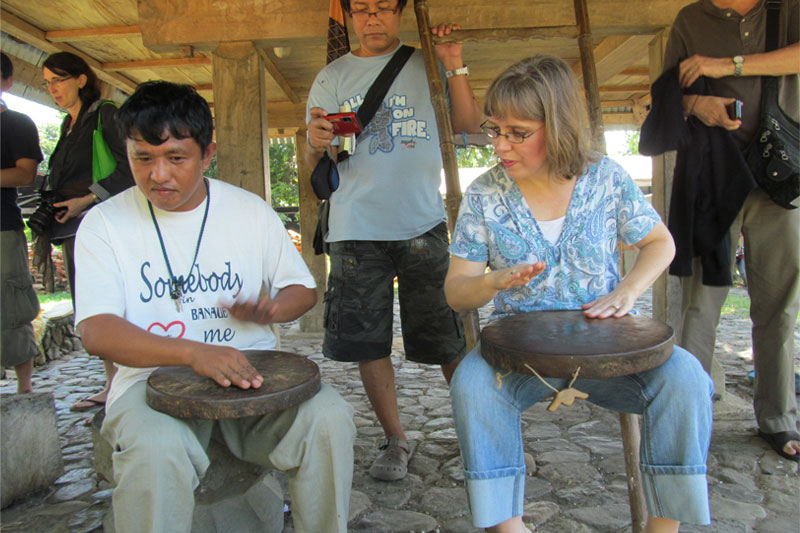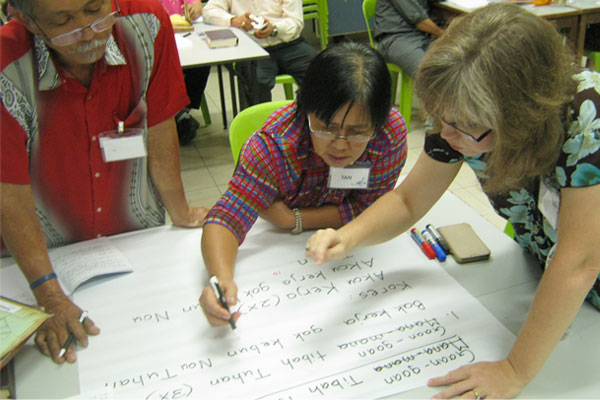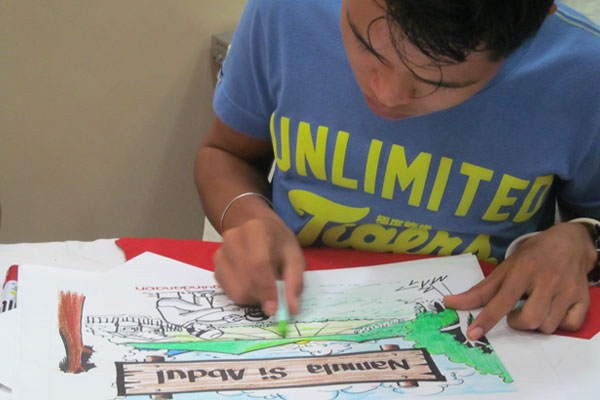Interwoven: EthnoArts and Bible Translation

“We had always supported missionaries, loved missions,” Laura Hultstrom explained, “but our plan was that someday we would go in our retirement years so we wouldn’t have to raise financial support. God upped the timeline of that plan!”
Laura and her husband Donald have been serving with Wycliffe Bible Translators since 2006 in management and EthnoArts roles, but it wasn’t until Donald left his operations management role at an electrical engineering firm that they began considering missions. “We kept praying, asking God where he wanted us,” Laura said. After two months of unemployment, Donald showed up at the Wycliffe headquarters to volunteer. Soon, he was assisting as the materials buyer for a building project and before long, he and Laura were challenged to consider going into full-time missions now.

Laura recalled: “Immediately I was ready to go, but Donald said we should pray about it. I responded, ‘Okay, you pray about it, and I’ll pray for you!’” Laura laughed. Two weeks later, the couple realized God had a place for them in full-time missions, and they later moved to Davao City, Philippines with their 9- and 11-year-old sons.
Donald took a role in management, and because of Laura’s music teaching and directing background, she taught music in a local international school. But after two years, Laura wanted to use her gifts in a different way. So in 2012, she began to take some courses in EthnoArts.
“I fell in love with it!” she said.
Why EthnoArts?
The goal of EthnoArts is for people to connect with translated Scripture in a culturally relevant way, primarily through music, drama, dance, visual arts and verbal arts.
“You can’t separate people from art and you can’t separate Scripture from art,” Laura explained. “[For example] poetry is woven throughout Scripture. So how do we communicate poetry in a more meaningful way in Bible translation? … How do they write poetry in their community? That’s essential!”
As an EthnoArts specialist, Laura spends much of her time listening to the needs of minority communities, advocating for the use of ethnic art forms in worship and training community leaders in EthnoArts workshops.
The workshops have a dual purpose for the Filipino communities — cultural empowerment and sharing the gospel. “The EthnoArts training is basically a discipleship program,” Laura shared. Many of the indigenous language communities feel marginalized compared to the majority language groups. Furthermore, many Filipino churches are not certain how to incorporate traditional art forms into their worship. The workshops encourage the pastors and leaders to look at all community art forms and evaluate them through the lens of Scripture.
Laura said: “Of the art forms that they feel they can’t bring into the church, we ask, ‘Why?’ and ‘Can they be redeemed?’ We then explain that art was given to man by God, but man has corrupted some of the forms. But they can be redeemed and used to worship God. Sometimes all it takes is to change the color of a feather on a drum or the material used [to make] the handle of an instrument, and the previous negative association is broken.”


In the workshop, participants practice using traditional art forms to create new material to bring back to their churches. Through the workshops, communities also experience healing from trauma, strengthen their own cultural identities, receive education and connect with different generations. “It builds a bridge between the community and the church,” Laura shared, “helping to communicate the gospel in a meaningful and relevant way to the community”
EthnoArts Reach the Youth
Many young people in the Philippines are turning their back on traditional language and culture. After attending a course, one Filipino elder said, “If we, in this community, had the EthnoArts training many years ago, our young people would not be in the state of rebellion that they are now.”
One Filipino pastor struggled to create and sustain a youth program at his church. But after attending an introductory EthnoArts workshop, he held an after-school music camp for the young people in his community. He taught the students different instruments, shared the gospel and helped them create Scripture songs in their own language and style. After the camp ended, the students came back for more lessons and started inviting their families to church. A youth program was born and eventually nine young people came to know Christ and were baptized!
“I Don’t Need That Anymore”
In Filipino culture, it’s rude to confront someone directly about an issue; it’s better to let a third party explain. For many Filipinos, art is that third party. They can see themselves in the art form and, through it, God can change their lives. A Christian community leader named Petrus witnessed this firsthand.
Petrus’ sister, who ran a modeling agency, called him one day. A young Filipino woman, who had been modeling in New York, wanted to come back to work in the Philippines so she could reconnect to her ancestors and their beliefs.
“Can I bring her to you?” Petrus’ sister asked.
Petrus agreed. He and his colleagues created a chant similar in style to a traditional one that the young woman was used to. But instead of calling on the ancestors for help, this chant focused on the Holy Spirit. When Petrus’s sister and the young woman arrived, they were greeted by Petrus and his colleagues performing the chant. The woman broke down in tears. “I feel like I’ve come home,” she said.
Over the next week, she fellowshipped with and heard teaching from the local Christians. When she arrived, traditional amulets, crystals, and charms covered her body like an armor. But one by one, she began taking them off. “Tell me more!” she begged. By the end of the week, she accepted Christ as her Savior and was baptized in the river.
The young woman had removed all of the traditional jewelry except for one amulet which was deeply precious to her. As she said her goodbyes, suddenly the amulet dropped to the ground! When an amulet strikes the ground in her culture, it’s believed to lose all its power.
The woman looked at the amulet on the ground and said, “I don’t need that anymore. I have Jesus.”
Not a Western God
Laura’s helped establish over 30 Filipino EthnoArts trainees and facilitators as well as a Filipino EthnoArts training course in Davao City.

Even though EthnoArts hasn’t always been easy, Laura remains passionate about seeing people come to know the Lord through a gospel that’s communicated in a clear, meaningful and relevant way.
“God created over 7,000 languages in this world, and he is fluent in them all. People can come to him in their own language, and he already knows it.
“[Many Filipinos] believe they have to become Western to be Christian. We say you don’t need to abandon your indigenous language and community. God is a God for all people, not just a Western God.”
Learn more about EthnoArts and Bible translation, including ethnomusicology!



